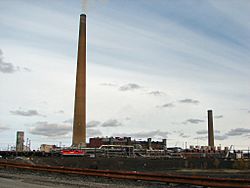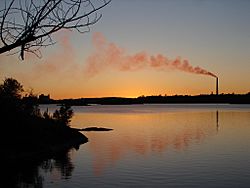Inco Superstack facts for kids
Quick facts for kids Inco Superstack |
|
|---|---|

The Vale-Inco (former Inco) Superstack at the Inco Copper Cliff smelter
|
|
| Alternative names | Vale Superstack |
| Record height | |
| Tallest in World from 1971 to 1987 | |
| Preceded by | Mitchell Power Plant |
| Surpassed by | Ekibastuz GRES-2 Power Station |
| General information | |
| Type | chimney |
| Town or city | Greater Sudbury |
| Coordinates | 46°28′48.23″N 81°3′23.43″W / 46.4800639°N 81.0565083°W |
| Construction started | 1970 |
| Completed | 1972 |
| Cost | $25 million |
| Owner | Vale Limited |
| Height | 381 m (1,250 ft) |
| Dimensions | |
| Diameter | at base: 35 m (115 ft) at top: 16 m (52 ft) |
| Technical details | |
| Material | reinforced concrete with stainless steel liner |
The Inco Superstack is a very tall chimney located in Sudbury, Ontario, Canada. It stands at an amazing height of 381 metres (1,250 ft). This makes it the tallest chimney in Canada and the entire Western Hemisphere.
It is also the second tallest freestanding chimney in the world. Only the GRES-2 Power Station chimney in Kazakhstan is taller. The Superstack is also the second tallest freestanding structure in Canada. Only the CN Tower is taller.
The Superstack is part of Vale's Copper Cliff processing plant. This plant is the largest nickel smelting operation in the world. Smelting is a process that extracts metal from its ore using heat.
In 2018, Vale announced that the Superstack would be taken out of service. This process began in 2020. By July 2020, the stack was officially no longer in regular use. It stayed on standby for two more months as a backup. After that, the Superstack began to be taken apart.
Taking the Superstack out of service helps the environment. It is expected to cut sulfur dioxide emissions by 85 percent. It will also reduce the plant's natural gas use by half.
Contents
Building the Superstack
The Superstack was built by a company called Inco Limited. Later, Vale bought the company. The cost to build this massive chimney was about $25 million. Construction started in 1970.
A powerful tornado hit Sudbury on August 20, 1970. This happened while the Superstack was still being built. The tall structure swayed a lot in the strong winds. But it stayed standing and only had minor damage. Six workers were on the construction platform when the storm hit. Luckily, all of them survived.
The very next day, August 21, was the final day of construction. The Superstack was fully completed by that evening.
Superstack's Time as the Tallest
The Superstack started working fully in 1972. From the time it was finished until 1987, it was the tallest smokestack in the world. The Ekibastuz GRES-2 chimney in Kazakhstan then became taller.
Between 1972 and 1975, the Superstack was also the tallest freestanding structure in all of Canada.
Why the Superstack Was Built
Before the Superstack was built, the gases from the smelter caused a lot of damage. The Copper Cliff smelter already had some tall chimneys. Two were built in the 1920s and 1930s. But these were not enough.
The pollution, along with cutting down trees for fuel, caused almost all the plants to die. Even the rocks in the area were affected. They turned charcoal black from the pollution and acid rain. This black layer went up to three inches deep into the once pink-grey granite.
The Superstack was built to send harmful gases high into the air. These gases included sulphur gases and other byproducts from the smelting process. By releasing them high up, the gases would usually blow away from Sudbury. However, these gases could still be found in the air up to 240 kilometres (150 mi) away.
In the 1970s and 80s, the sulphur dioxide often formed a thick, cloud-like plume. This plume could be seen across the entire horizon. Sometimes, due to weather conditions called "inversions," the plume would fall back down into the city.
Cleaning Up the Environment
After the Superstack was built, a big project started to clean up the environment. This project helped to fix damaged land and water bodies. One example is Lake Ramsey.
An ambitious plan to regreen the area also began. Over three million new trees have been planted around Greater Sudbury. In 1992, Inco and the city received an award from the United Nations. This award recognized their great work in environmental cleanup.
Superstack's Future
On November 3, 2014, Vale announced they might stop using the Superstack. This was because of a $1 billion project to greatly reduce emissions. This project meant the Superstack was no longer needed for its original purpose.
If no other use was found, Vale planned to take it out of service and replace it. They would build a much smaller chimney instead. In 2017, Vale confirmed plans to decommission the Superstack. This would happen after two smaller, more energy-efficient stacks were built.
On July 28, 2020, Vale announced the Superstack was officially out of service. It remained on "hot standby" for about two months. This allowed time to test the new connections. The Superstack will now be taken down over the next few years.
Environmental Impact and Improvements
While the Superstack helped reduce pollution right in Sudbury, it spread gases over a larger area. These gases included sulfur dioxide and nitrogen dioxide. Acid rain, partly from the Superstack, affected many lakes. By the late 1980s, about 7,000 lakes were impacted.
In the early 1990s, Inco made major improvements. They installed equipment to clean waste gases before they went up the Superstack. These upgrades were finished in 1994. Since then, emissions have been much lower. The plume from the stack now disperses quickly and is often see-through.
Because emissions are so much lower, the natural flow of air is not always enough. Fans or heating the gases with natural gas are sometimes needed to push them up the stack.
The Superstack also released metals like arsenic, nickel, and lead into the air. In 1998, Inco released a lot of lead from Copper Cliff. This was much higher than what was allowed by US rules for lead smelters.
Because of the lead emissions, soil tests in the nearby community of Copper Cliff showed high lead levels. These levels were enough to be harmful to young children. However, with the recent 85% reduction in emissions, this situation is expected to improve significantly.



